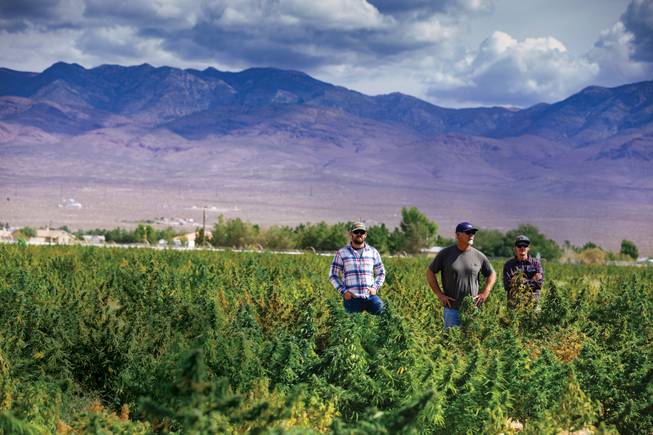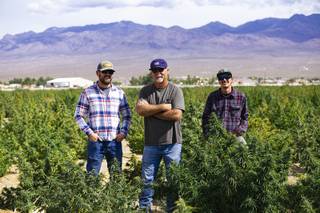
Harris Farms assistant foreman Jordan Williams, from left, owner Dan Harris and plant specialist Brad Thurmond stand in a marijuana field in Pahrump.
Thursday, Oct. 3, 2019 | 2 a.m.
Across America, bud is blooming.
Outdoor cannabis cultivators are preparing to harvest their crop this month, marking the end of an eight-to 10-month annual process. The seeds of many cannabis strains grown outdoors, especially in western states like Oregon and California, are planted in the winter, sprout in the spring, grow in summer and germinate and blossom in the fall.
The resulting harvest, which usually lands in October, is sometimes referred to as croptober — a time when swaths of cannabis grown outdoors line the shelves of dispensaries all at once, often lowering market prices.
“It’s great for the consumer. You get a flood of product. The demand hasn’t changed, but the supply is much higher,” said Brandon Wiegand, regional general manager for the cannabis company Nevada Organic Remedies.
Ganja Glossary
• THC: Short for tetrahydrocannabinol, it’s the psychoactive chemical in cannabis.
• CBD: Short for cannabidiol, it won’t make you high. But it may help relieve anxiety and pain.
• Hemp: A low-THC varietal of cannabis sativa that’s used for industrial textiles, such as rope or paper and CBD products.
• Terpene: An aromatic chemical naturally produced by some plants and flowers. According to leafly.com, more than 100 varieties of terpenes have been found in cannabis plants. Different terpenes will produce different aromas, flavors and effects.
• Certificate of Analysis Product testing results of marijuana, available for legal marijuana products in Nevada.
• Sativa: Strain of cannabis often considered energizing.
Despite croptober’s significance in certain states, its impact in Nevada is minimal. Nevada dispensaries saw a slight dip in sales last October, possibly because of more outdoor-grown supply from other states entering the illegal market, said Riana Durrett, executive director of the Nevada Dispensary Association. She hopes that won’t be the case this year, especially because of the greater risks associated with illegal cannabis.
Whether or not a true croptober could come to Nevada anytime soon, industry leaders say, depends primarily on where and how we grow our cannabis.
Most of the cannabis produced and sold in Nevada grows in tightly controlled indoor environments, where harvest time happens year-round. Hence, no croptober.
Trending now
■ Education. The industry is working to educate consumers about the complexity of the flower and its effects beyond a high, according to Nevada Dispensary Association Executive Director Riana Durrett.
■ Beginning January 1, 2020, Nevada will be the first state in the nation banning pre-employment drug screening for marijuana. The new law won’t apply to those with jobs where safety is an issue, such as firefighters and EMTs. Employers will still be able to fire you for being impaired on the job.
■ The Grove’s Tiffany Hoven says there is “a trend in quality when producing, growing and purchasing products for the market.”
■ Nathan Gomez of Essence Cannabis Dispensary says a big trend in cannabis is using online ordering and pick-up as the new way to purchase products. He says it’s “a much faster and easier way to get what you need without having to wait in line.”
With indoor growing, a process that typically takes many months and happens once a year is truncated into 100 days, give or take, Wiegand said. Light, temperature, humidity and nutrients are controlled to optimize the product and speed up the growing process. Those elements can be altered to mimic different seasons; for example, the plant might be exposed to more light and higher temperatures to induce the summertime growing phase, Wiegand said.
Indoor cultivators can also grow different strains on different harvest schedules, ensuring they have fresh product at all times. At cannabis company Planet 13’s indoor cultivation facilities in Beatty and Las Vegas, different rooms with disparate controlled environments produce more than a dozen cannabis strains throughout the year, said Chris Wren, vice president of operations.
In other words, while Nevada doesn’t experience croptober, consumers here enjoy a benefit not seen in some states: fresh and plentiful marijuana year-round.
“We always have fresh flower coming down, we always have product on-site, and we’re always able to kind of keep the machine turning,” Wiegand said.
Nevada Organic Remedies, which owns The Source dispensaries in Henderson and Las Vegas, has indoor cultivation facilities in Pahrump and Las Vegas. They produce a combined 70 pounds of product per month, Wiegand said, using hydroponics-style indoor growing.
While outdoor cultivators are dependent on the changing seasons and are at the mercy of Mother Nature, indoor growers are able to easily modify the environments in which the plant grows. The result tends to be a more consistent, higher-quality product in addition to producing consistent supply year-round.
“Most people would agree that there’s a higher level of quality for indoor grows. You’re just able to do more and control the environment better,” Wiegand said.
Outdoor growth still a rarity in Nevada
The prevalence of indoor cannabis cultivation in Nevada can be attributed to a handful of circumstances here.
Although recreational marijuana became legal in January 2017 and facilities began opening that summer, outdoor growth remained illegal until January 2018, when the state’s Department of Taxation approved permanent regulations to govern the industry, Durrett said.
As a result, only a few outdoor growers have come online so far.
Nevada’s exceptionally rigorous standards for product testing, freshness and safety also inhibit outdoor growing to an extent, Durrett said. For example, many pesticides aren’t allowed to be used for cannabis cultivation in Nevada under rules established by the state Department of Agriculture.
“It’s difficult to comply with all the testing standards if you’re growing outdoors, because you’re vulnerable to pests,” Durrett said.
While those standards increase production costs for cannabis companies, they also ensure that consumers are getting one of the best products on the market, Wiegand said.
“What we know is that the product we put out has gone through rigorous testing. We know it’s free of heavy metals and pesticides and dangerous and harmful chemicals,” he said.
Depending whom you ask, Nevada’s climate complicates outdoor growing as well. That’s the primary reason Nevada Organic Remedies doesn’t anticipate pursuing outdoor growing anytime soon, Wiegand said.
“Given the heat and given the intensity of the sunlight, it makes more sense for us, in our opinion, to be indoors,” he said.
Nonetheless, industry experts agree that there are benefits to outdoor growing. The plants can grow to a larger size, Wiegand said. Perhaps most significantly, by relying on natural sunlight instead of energy-intensive lighting and climate-control, costs are lower outdoors.
At present, Planet 13 has no plans to explore outdoor cultivation, Wren said. But he predicts that Nevada will start to see more outdoor cultivation because of the lower costs.
“It is the future in terms of mass production for everything besides shelf-quality flower,” Wren said.
One of the few Nevada cannabis companies to have made the jump into outdoor cultivation is Acres Cannabis, which sells product out of its Las Vegas dispensary and grows it at a facility in Amargosa Valley. Some of the company’s cannabis grows in a greenhouse there, while some grows in the open air, said CEO John Mueller.
Cultivation in the greenhouse is similar to cultivation indoors in terms of the timeline and growing cycles, Mueller said. The biggest difference—and benefit—of greenhouse cultivation is that less energy is needed thanks to the power of the sun.
“We don’t have the extensive HVAC systems, and electric bills are significantly lower,” he said.
Although Nevada’s climate influences cultivation, it by no means makes outdoor growing impossible if you know what strains to plant and how to tend to them, Mueller said. In fact, he said cannabis plants benefit from Nevada’s aridity by being less susceptible to mold.
“You select genetics that are conducive to your growing environment,” he explained.
Acres’ outdoor cultivation facility grows autoflowering cannabis, a genetically modified version of the crop that sprouts and flowers regardless of sunlight patterns. Acres extracts THC from the autoflowering plants for use in vape pens, edibles or ingestible products. That means the overall “look” of the plant is irrelevant, since consumers will never see it, Mueller said.
“Basically, every state, including Nevada, is moving more and more toward the vape pen, edible or ingestible,” Mueller said. “That’s going to end up being at least 50% of the market and should be closer to 70% of the market as we get decades in the future.”
Acres won’t be celebrating croptober at its outdoor cultivation facility, given that the cannabis grown there will actually harvest in early November, Mueller said.
Nor will consumers across the state notice much of a difference this time of year when it comes to prices or supply, Wren said.
Regardless of whether Nevada moves toward outdoor cultivation and experiences croptobers in future years, one thing is certain: Thanks to the comprehensive regulatory process and tightly controlled growing environments, cannabis made and sold here is predictable, high-quality and almost always fresh.
This story originally appeared in the Las Vegas Weekly.

